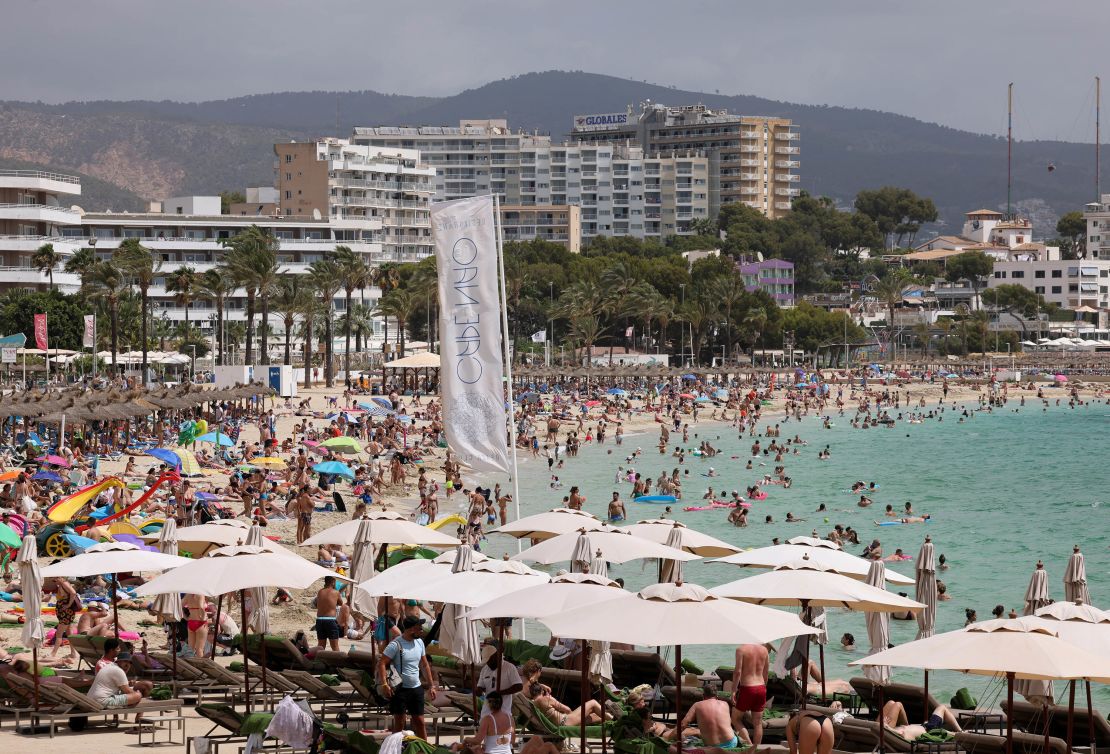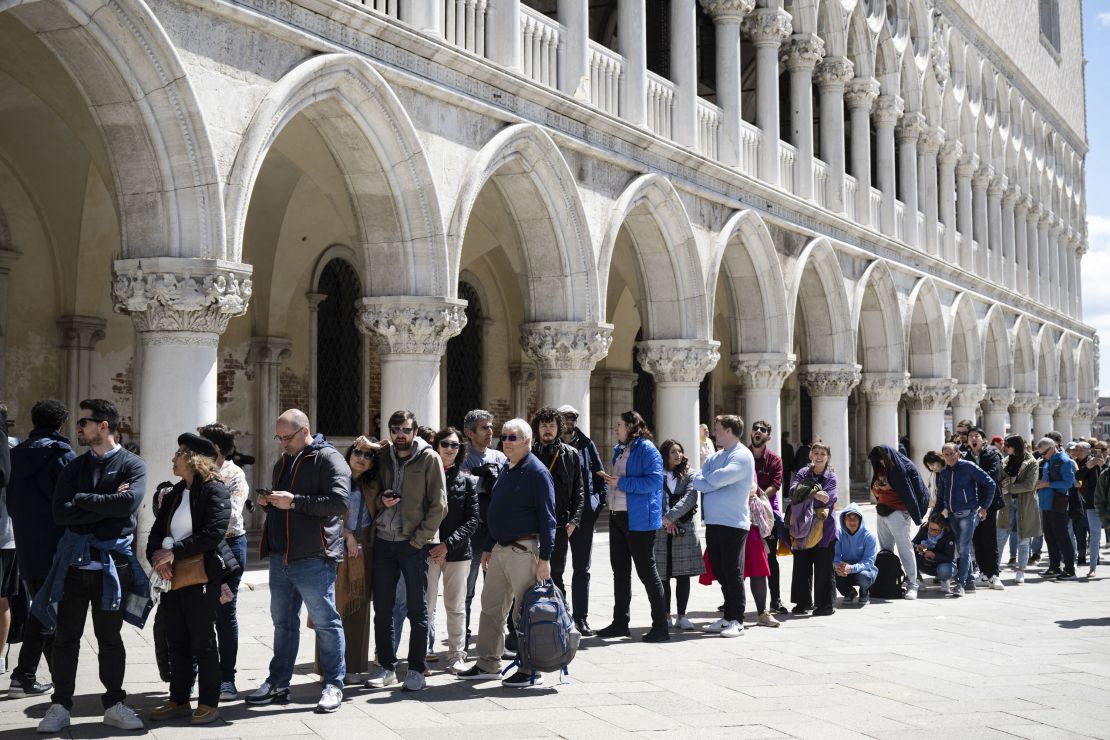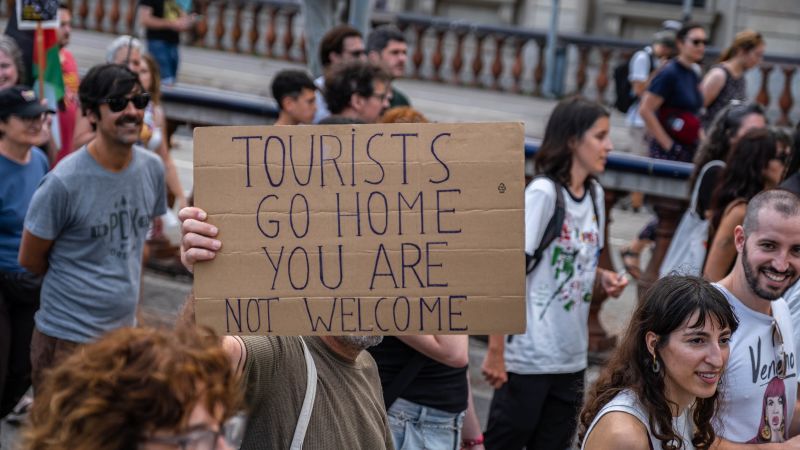CNN
—
Anti-tourism protests have been sweeping across Europe this summer, with demonstrations taking place in the Netherlands, Greece, and of course, Spain.
In early July, protesters marched through popular tourist areas in the Spanish city of Barcelona spraying unsuspecting visitors with water pistols while chanting “tourists go home.
And most recently, thousands protested in the Spanish island of Mallorca, with organizers claiming the island’s tourism model “impoverishes workers and enriches only a few.”
At the center of the protests lies the growing issue of rising rents and house prices, which has made home ownership almost impossible for some residents.
Carlos Ramirez, a school teacher in Barcelona, northeast Spain, has been saving for his first house for years and earns a “decent” state salary, he says.
But prices in the Catalan capital are skyrocketing and Ramirez, 26, fears he will be driven out.
“Everyone I know lives here,” he told CNN. “But the only way you can afford to live right now in Barcelona is sharing with two, three, four people.”
Like other residents in Southern Europe whose cities double as popular summer travel destinations, Ramirez puts much of the blame for the increasing costs on one thing: mass tourism.
“It’s becoming more and more difficult for locals, especially younger people, to have their own place,” he said. “As the years have gone by, more and more tourists have come.”
In Barcelona, rents have increased by 68% over the past decade, according to the city’s mayor Jaume Collboni – a pattern that is mirrored across other European cities.
Many residents have had enough. Some have taken extreme measures to make their voices heard, with locals demonstrating against excessive tourism in the Spanish Canary Islands calling for a hunger strike back in April.
When anti-tourism protesters started to fire water pistols at visitors in the Barcelona city center on July 6, a moment that gained international attention, Ramirez said he could “feel the resentment” in the air.

He says he was pleased to see so many residents join the demonstration, which some 2,800 people attended according to Barcelona’s City Council.
“A lot of people, a lot of companies, are now warning tourists about visiting Spain because of hostility and all of that. Frankly, I think it worked,” Ramirez said, reflecting on the ability of the protests to dissuade tourists from visiting the city.
Antje Martins, an expert in sustainable tourism from the University of Queensland, said the reputational impact of such protests could influence where tourists decide to travel.
“Barcelona now has a really bad reputation for other tourists who don’t want to visit because they’re scared,” she said.
But Eduardo Santander, CEO of the European Travel Commission, a nonprofit association responsible for the promotion of Europe as a travel destination, suggests that incidents like the protests in Barcelona are “isolated” and do not “reflect the complete reality of Spain or Europe.”
Generally, Martins believes that this isn’t a clash between tourists and residents.
“For me, they’re a broader reflection of tourism that is not sustainably managed,” she said.
“When I see those clashes where residents are sort of revolting against tourism… I think that’s a reflection of them not being happy because they don’t get any benefits from the tourism that they see,” she added.
Ramirez agrees with this sentiment.
“I can empathize with them, we are not blaming the tourists directly,” he said. “We want to pressure our government to change policies.”
The main issues at play here are structural, not personal, Martins said.
Residents who are priced out due to unsustainable levels of tourism are typically paid lower wages and some are working in the tourism industry itself, she added.

In some European cities, local authorities are taking bold action in a bid to bring tourism levels under control.
Officials in Venice have recently hailed a temporary entrance fee, designed to regulate tourist numbers, as a success.
The new €5 (about $5.4) tourist charge, which began on April 25 and concluded on July 14, brought in more than €2.4 million (about $2.6 million), significantly more than expected, according to Venice mayor Luigi Brugnaro.
Some residents told a CNN team on the ground that while still busy, crowds seemed smaller during the scheme. But others don’t agree.
Susanna Polloni, from the Venice-based Solidarity Network for Housing group, told CNN the tax is “not only useless, but also harmful,” as it brings into the international imagination the idea of a “Veniceland,” where you must buy a ticket to enter.
Polloni adds that mass tourism has already caused healthcare services to close, neighborhood shops to be replaced by souvenir shops and house prices to boom in Italy’s canal city.
“We are about to reach a point of no return,” Polloni said. “We think that our cry for help, from a city that is dying for the profit of a few, should reach the whole world.”
Despite backlash from some, more cities across Europe are following suit, and some are even looking to expand their tourist charges.
Barcelona’s mayor Jaume Collboni announced recently that he wants to raise the city’s tourist tax for some cruise passengers.
Tourists who visit the city for less than 12 hours typically cause extra crowding at the main attractions of Sagrada Familia cathedral, Las Ramblas pedestrian walkway in the Gothic Quarter and at Gaudi’s hillside Park Guëll, the city’s press office told CNN.
The current tourist tax is Barcelona’s third-largest source of funding, raising about €100 million (about $108 million) last year from cruise passengers – who pay €6.25 (about $6.8) to enter the city – and other visitors who stay in hotels and other tourist lodgings.
Collboni said he also wants to end licenses for around 10,000 apartments currently approved for short-term rentals, the press office said.

It’s not just housing issues that have generated a backlash against tourists, Ramirez said, adding that the disrespectful behavior of some has also played a part.
In Italy’s Florence, a young woman was recently filmed kissing, humping and grinding against a statue of Bacchus, the god of wine and sensuality, with the mayor’s office calling it an act that “mimicked sex.”
And in 2023, a tourist was accused of damaging a statue in the city’s 16th-century Fountain of Neptune, located in the Piazza della Signoria.
The same year, in another part of Italy, a group of tourists were accused of toppling a valuable statue at a villa.
Bad tourist behavior has been a problem across other parts of Europe too, including Barcelona, Mallorca, Magaluf and Benidorm, Ramirez said.
“It seems like they do here what they can’t do in their own countries,” he told CNN. “We feel very insulted.”
Sebastian Zenker, a professor in tourism at Copenhagen Business School, explains how these types of incidents have led to some cities running “de-marketing campaigns,” which aim to discourage certain tourists from visiting.
Zenker points to Amsterdam’s 2023 “Stay Away” campaign, which targeted male visitors between the ages of 18 and 35 with adverts warning them about the consequences of anti-social behavior.
“That was a very tough and strict way of de-marketing,” he told CNN. “It did not stop bachelor parties, but it created an awareness that this city has changed the rules.”
Efforts to attract more cultural tourists can have unintended consequences though, Zenker said.
“If you increase prices and you attract more wealthy people, this solves the crowding effect, but at the same time it increases the inflation and the gentrification problem.”
In Mallorca, prices have gone “super crazy” after many activities for “drinking tourists” were banned, says Zenker.
Much of the money raised won’t make it back into the hands of local communities, he added.
So, what is the solution?
“It’s about seeing the money that is made by tourists, or with tourists, being invested in the place and in jobs so people can afford to live,” he said.
“This [the protests] will go on, until we find a balance again.”











